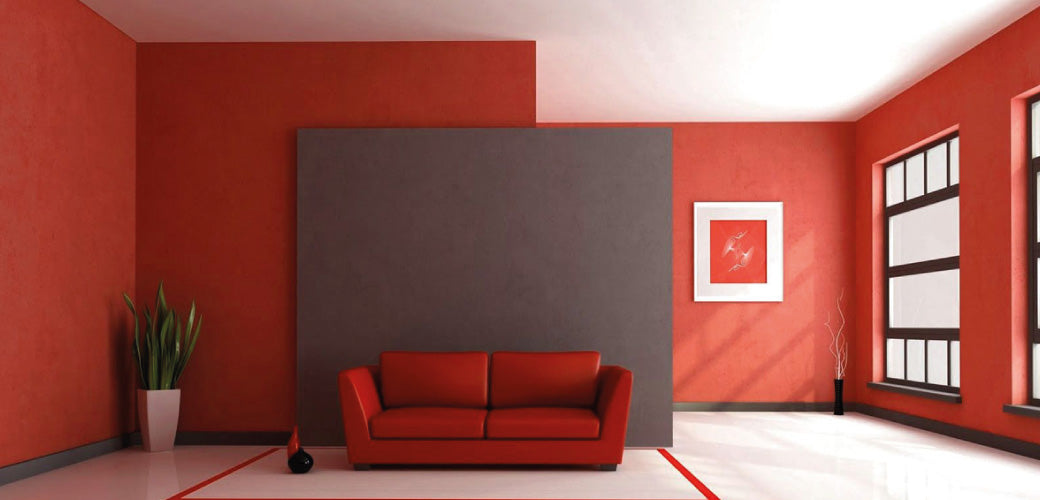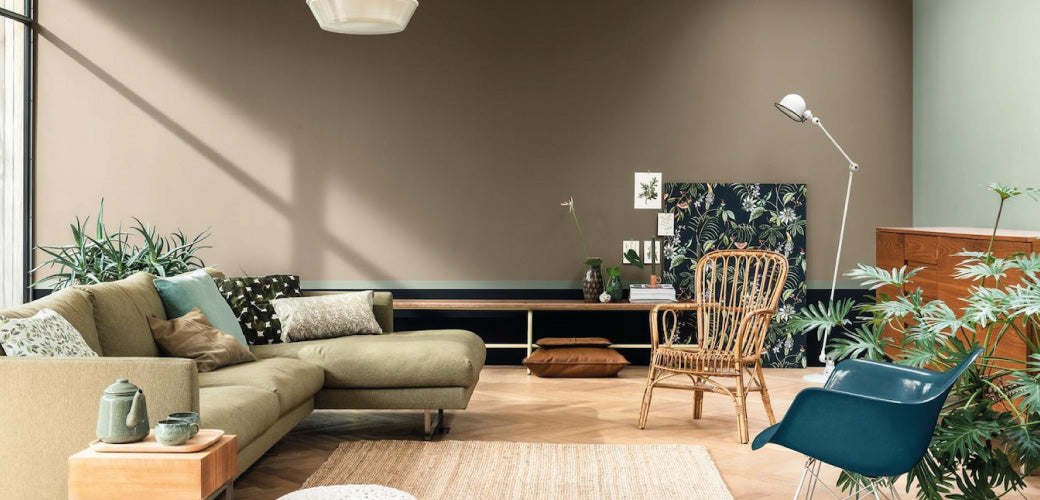Give your room a dramatic transformation without spending a lot of money
Posted by Robert Harte on

Paint is the number one tool in the home decorator’s arsenal. It’s inexpensive, easy to use, and the possibilities of what can be achieved with it are endless.
Painting the walls is one of the easiest ways to give a room an awesome look. You can also try painting patterns like stripes, chevrons or other geometric designs. Or you can try techniques like colour blocking; there’s no end to the possibilities. But where to start? Interior Designer Garry Cohn has all the answers.
“Any interior designer will tell you that colour has the power to transform a room, whether it’s a bold accent wall or an unexpected painted ceiling. Most people know that they want a cool, glamorous look but are afraid to make such bold choices.
“My first piece of advice is that you go along to your local Homevalue store and pick up the paint brochures,” Garry says. “All of the main brands have fabulous room shots showing how colour can be used to make a statement in any room.
Take home the brochures, look at them in the context of your room and if you love a colour, get sample pots from the store and take them home to try out in your own environment.”
A good piece of advice is to choose the paint colour of your room last, and consider the existing architecture and finishes first. This is because there is such an extensive range of colours for paint, whereas in other design elements like furniture and flooring, the options are more limited. So, start with what you already have and what you need to keep in the room.
Look at the upholstery of your furnishings, the flooring and accessories. Big ticket items like furniture may have to stay, so work with what you’ve already got, and think about the tones of flooring material, cabinetry and existing furniture that needs to stay before you select a colour palette. That said, it is very easy to upcycle furniture with a fresh dab of paint, so you are not necessarily bolted into what you already have, just consider how the existing features of your interior will work in harmony with your chosen colour palette.
Tints, Tones & Shade

When choosing colours for your interior, there are a few terms that you need to get familiar with – Tint, Tone and Shade.
Tint refers to how light a colour is. Adding white to a colour will change the tint. Tone refers to the depth of a colour. Mixing grey to the colour will affect its tone. Shade refers to the darkness of a colour. The term is also used when referring to similar colours such as ‘shades of green’ or a ‘darker shade of blue’. Mixing black to a colour will alter the shade.
“By using all three elements you can create a look that is exciting and interesting,” Garry says. “Here is the trick, just use one colour and apply variations of that colour.”
Here are some examples.
If you want to keep the colour light and neutral add depth and interest by painting an accent to doors in a contrasting colour and/or apply colour to the window and door edge or around the threshold (archway).
Choose one base colour but use more saturation to the colour and you will see how the mood of the room can change. You achieve this by choosing different tones of the same colour. This will feel designed and considered. Alternatively, block areas of your space and leave the rest neutral. By offsetting the blocks of colour, they add an element of surprise and a wonderful conversation piece.
Paint Finish

Before you begin you have to think about the finish. Choosing a paint finish for interior walls depends on the desired amount of shine and durability. In kitchens, for example, avoid flat or other types of matte paints, as they can be difficult to wipe down. Satin or eggshell sheens work well here or even a semi-gloss for ease of maintenance. Likewise in bathrooms, due to moisture, you need a wall surface that you can easily wipe down.
Paints with glossier sheens have a tighter molecular structure than flat paints, making it more difficult for moisture to penetrate. By contrast, living rooms and bedrooms are low-impact areas. Since these tend to be forgiving spaces in terms of impact, you can use flat or matte paint which has a more sophisticated finish.
There is an entire army of people at your disposal in your local Homevalue store who know all about tints and finishes. They are there to help, so don’t be afraid to ask.
Room Size

Not every home is blessed with expansive room sizes, in fact, the three bedroomed semi is the most common house in Irish cities, so room sizes are not overtly generous.
There are some cool tricks you can use to making a room seem bigger Garry says. Choosing a ceiling colour that is in the same range of hues to the colour of the walls tricks the eye into seeing a more expansive space as you are less aware of where the wall ends and the ceiling begins. It also looks pretty cool and cozy. Another trick is to use the same colour to paint woodwork (like cabinets, trims and crown molding) as you used on the walls. This creates great visual interest and can make walls appear taller.
If you are painting a small space that doesn’t get much natural light, you might think that opting for a lighter colour is best, however, if the room lacks natural light, darker colours can push the boundaries of the wall out and create a more defined feel.
Choosing your Shades

We are all guilty of playing it safe. Yes, you want to paint a room, but the line of least resistance is often the safe scheme in cream or beige. For this reason, many people opt for a monochromatic palate.
Monochromatic spaces are those that are decorated with shades of one main colour and are one of the most popular trends in interior design. Following this pattern, you use the same colour scheme with different hues throughout all the elements in the room. This theme is often one that is used unconsciously, for example using cream or beige and adding elements like furniture and accessories in contrasting shades.
The monochromatic interior is relatively easy to achieve and can be visually effective, however, it can also be monotonous if you simply just stick to the same shade.
Playing it too safe can result in a bland, unfinished look, so if you are leaning towards a monochromatic scheme, use a selection of different tones and tints of the same colour throughout the space. For example, instead of painting all the trim in white (skirtings, sills, cornice etc) try painting the trim the same colour as the walls. This is an old trick to make a room look larger, by not defining edges with white trim.
Bear in mind that a monochromatic scheme does not have to be pale. Try going a tone darker to add more depth and elegance.
Two Tone Shades

Why paint a room’s walls just one colour when you can use two? Two-tone painting creates visual interest by using two colours on one wall, divided horizontally. This technique allows you to be creative in your rooms’ colour scheme and can even make neutral colours more interesting by using different shades of the same hue.
Garry suggests leaving the bottom of the walls neutral and the top with the accent colours. “I love going to the next level and painting the split. On the furniture as well, this really creates a space that is fun and artistic,” he says.
“One of my favourites with a split room is to either paint or match the colours in the furniture to match the colour on the wall. What it does is actually make a room look bigger by having the furniture blend in with the wall.”
Earthy Tones

Grey is a go-to colour, a timeless shade that is subtle, luxurious and long lasting in any interior space. It is one of those versatile colours that can take on a range of personalities. It’s also said to stir a feeling of calm and composure – a quality that’s ideal for family homes. Shades of grey contrast beautifully with a white ceiling and skirting board and the colour lends itself to pops of colour in accessories such as sunny yellow.
Earthy Sandstone is the perfect colour touch for the “less is more” approach. Pair it with other tonal shades to give a calm and rustic vibe to a room or incorporate more saturated opponents such as a golden finish for a dab of glamour.
Green is an extremely positive hue as it stimulates thoughts of balance, growth and restoration in colour psychology. It brings the natural world to mind and it is a way to bring a refreshing sense of nature indoors, especially in city homes with little surrounding greenery. It’s also a shade that works well when connecting the outdoors to indoors, taking the eye from an internal wall colour to greenery of the garden.
Classic blue is still very much at the top of the style stakes and is without doubt one of the strongest hues of the colour psychology spectrum. Lighter shades instil a feeling a of calm and tranquillity which makes them great for bedrooms, bathrooms and living spaces where you want to relax.
Accessorise
Whether you’re choosing colours for your walls or for your furnishings, reinforcing your palette through other items in the room can help create a stronger aesthetic. For example, if you’ve chosen various shades of blue as your scheme, look for other colours that work well to enhance it. This may mean adding more neutrals, blacks or greys in the form of cushions, fabrics, throws or accessories to strengthen the overall appearance of your interior. Accessorising in this way doesn’t break the bank but adds little touches of colour and elegance.
Black & White

Now for the ultimate harmonious contrasting, black and white. A contrasting design is very appealing to the observer, it creates a foreground and background. It also gives a flat surface a three-dimensional quality which tricks the eye into thinking that they are either floating or that the room is bigger than it really is.
Normally a ceiling is white and that is for two major reasons. One, it makes the ceiling seem taller that it is, and secondly, to make the room reflect more light into the space to make it brighter. That said, it is not always the best application for everyone. A dark celling can also make a celling by giving the illusion of an endless night sky, and when you place lighter colours against a dark, they are brighter and more.
A Brighter Future
Embrace a world full of colours, neutrals, shades, tints and tones - and there is no need to be afraid to use them all - because they all work together. Finally, if I can leave you with one word of advice, if you paint a colour that doesn’t work, relax, its only paint, just paint it another colour.
